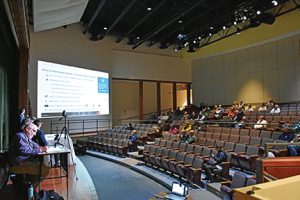
About 65 people attend in person, and 28 online for a presentation by MassDOT at a public meeting on 10/3/22 at Fairhaven High School to discuss options for replacing the Fairhaven-New Bedford swing bridge on Route 6. Photo by Beth David.
By Beth David, Editor
Officials from the Massachusetts Department of Transportation (MassDOT), and engineering consultants, held a public meeting on Monday, 10/3/22, at Fairhaven High School to present options for replacing the Fairhaven-New Bedford swing bridge, and to receive public comment on the project.
About 65 people attended in person, including all five Fairhaven Select Board members, Rep. William Straus (D-Mattapoisett, 10th Bristol), and Republican candidate for 10th Bristol Bob McConnell. New Bedford Mayor Jon Mitchell also attended for a short time to make a comment. Another 28 joined the meeting remotely.
Joseph Breen, MassDOT Project Manager on the project, presented a series of slides that included a history of the nearly 120-year-old bridge (it was completed in 1903), current conditions of the structure, and options for replacing it.
The antiquated bridge takes a long time to open and close, leaving people in vehicles stuck on Route 6 at Popes Island for at least 15 minutes while boats pass through. A new bridge would be faster, officials said. The plan would also be to raise the bridge to allow at least some smaller boats to be able to pass under the bridge without it opening and shutting off the road.
Mr. Breen listed the number of times over the years the bridge was inoperable due to repairs, and, therefore, had to remain open to marine traffic, closed off to vehicles.
“We’ve extended the life of the swing bridge several times,” said Mr. Breen.
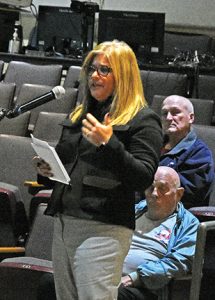
Fairhaven Select Board chairperson Stasia Powers addresses the MassDOT panel at a public meeting on 10/3/22 at Fairhaven High School to discuss options for replacing the Fairhaven-New Bedford swing bridge on Route 6. Photo by Beth David.
The final decision on a design will take into consideration the needs of all stakeholders, including commercial and recreational marine traffic, vehicle drivers, pedestrians and bicycles, local government, US Coast Guard and Army Corps of Engineers, and MassDOT.
The bridge opened 4,745 times in 2021, with more than 5,000 fishing boats and 3,000 pleasure crafts passing through, and 2,000 tug boats and towed vessels.
The bridge does have, or is supposed to have, a schedule for opening. It is supposed to open every hour on the hour, as needed, from 7–10 a.m.; every hour and 15 minutes past the hour from 11:15 a.m. to 6:15 p.m.; upon request from 6:15 p.m. to 6 a.m.
The goal is to build a bridge with a 75-year life span; to increase the opening so larger boats can pass through; widen sidewalks; shorten opening time; increase the under-bridge clearance.
Possibilities include a “no-build” option, which would simply keep repairing the existing bridge; another swing bridge; a bascule bridge (drawbridge); Dutch style bascule bridge; vertical lift.
The project will cost in excess of $100 million. This year’s transportation bond bill earmarks $100 million for the first phases of the project.
Mr. Breen said it is very early in the process.
“We want to get the public involved as much as possible,” he said.
At the next “25 percent” phase, a design will be recommended.
There is, however, very little chance that everyone will be satisfied.
“There are competing interests,” said Mr. Breen, noting road traffic, commerce, navigation.
He said there is no way to get “unanimity on a project like this.”
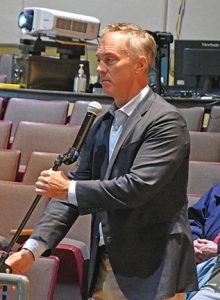
New Bedford Mayor Jon Mitchell addresses the MassDOT panel at a public meeting on 10/3/22 at Fairhaven High School to discuss options for replacing the Fairhaven-New Bedford swing bridge on Route 6. Photo by Beth David.
New Bedford Mayor Jon Mitchell addressed the MassDOT panel and the public, saying the project was “near and dear to my heart.”
He said he wrote a term paper on it in college.
“We have to deal with it in the Port of New Bedford,” said Mayor Mitchell. “It is antiquated. It is functionally obsolete.”
He said everyone knows what it is like to get “stopped on the bridge.”
“It’s a term we all know,” he said. “We’ve all experienced it.”
He said it was an opportunity to improve functionality for motorists, pedestrians and bicyclists, and to allow for larger vessels; to address sustainability; to minimize disruption; and to make it look good.
Pedestrians and bike riders should be able to cross the river without “taking your life in your hands.”
“Functionality in every respect is important,” said Mayor Mitchell.
He said the project needs to minimize disruptions, which are “profound” for the fishing industry and for road traffic.
Mayor Mitchell also stressed that the new bridge should look good.
“Aesthetics count,” he said, and spoke against a vertical lift saying it would be “exceedingly prominent.”
The bridge can be an eyesore, something to be embarrassed about, or it can be something to be proud of.
Fairhaven Select Board Chairperson Stasia Powers noted that more people will likely be using the bridge, with the train arriving soon. She said the bridge is deteriorating and will cause more problems.
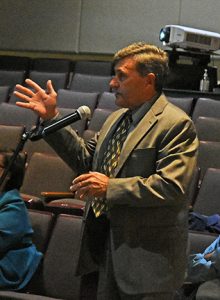
Fairhaven Select Board member Bob Espindola addresses the MassDOT panel at a public meeting on 10/3/22 at Fairhaven High School to discuss options for replacing the Fairhaven-New Bedford swing bridge on Route 6. Photo by Beth David.
Select Board member Bob Espindola asked about the pros and cons of the different designs.
Kevin Johns, Principal at Modjeski and Masters, Inc. (M&M), said all four designs are “viable candidates.” The deciding factors will include cost, the amount of disruption to local residents during construction, and other factors.
The problem, he said is that there are competing criteria. What is best for one group, may not be best for another.
“We have many options to choose form,” said Mr. Johns.
Fairhaven resident Karen Vilandry, president of the Hands Across the River Coalition, cautioned that there are PCBs buried in the harbor and the project managers need to be careful not to disturb them.
Thomas Cole, Project Manager at M&M, said the project would coordinate with all agencies, including the USCG and the Army Corps of Engineers.
Robert Valiquette advocated for improving the passage for large commercial fishing vessels.
Mr. Cole said the project needs to take into consideration the needs of marinas, mariners, fishing boats, but also the needs of the future.
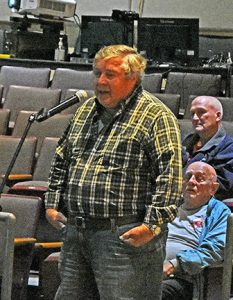
Robert Valiquette of Fairhaven addresses the MassDOT panel at a public meeting on 10/3/22 at Fairhaven High School to discuss options for replacing the Fairhaven-New Bedford swing bridge on Route 6. Photo by Beth David.
Bob McConnell, who is running for state representative in the 10th Bristol district asked what the 25% design meant.
Pam Haznar, Project Development, MassDOT, said that at the 25% point, there would be a formal design, and there will be lots of public hearings and comment opportunities.
“Why have a bridge at all,” asked John LaCroix, saying when he gets “caught” on the bridge, he goes around through Fairhaven and it is faster than waiting for the bridge. He said Route 195 is faster. “Why have it at all?”
And he received a round of applause for his comments.
Mr. Cole said they would be conducting traffic counts and studies.
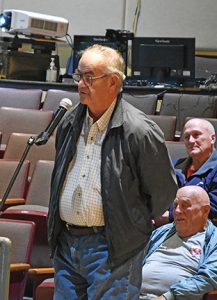
Robert Grindrod of Fairhaven addresses the MassDOT panel at a public meeting on 10/3/22 at Fairhaven High School to discuss options for replacing the Fairhaven-New Bedford swing bridge on Route 6. Photo by Beth David.
Robert Grindrod said he felt they were “reinventing the wheel.”
He said the project is going to take 10 years if it goes as projected, when in Maine they built a whole new bridge in 18 months. “So I can’t comprehend…a 10 year process.”
Martha Worley, who owns WorleyBeds on Popes Island at the bridge opening, said when they talk about road closures being as short as possible, she says, “I doubt it,” and urged “proper planning” to minimize disruptions.
“It affects us,” said Ms. Worley. “It affects our ability to do business. It’s terrible for the people who have to put up with it.”
She said people cannot get out of their driveways when traffic is backed up, and MassDOT has not been easy to deal with in the past.
“It’s a nightmare,” she said.
Travis Rapoza of Fairhaven asked if there would be economic studies to determine short term losses and the long term benefits to local businesses.
Mr. Cole said the economic cost will be taken into consideration when choosing a design.
Select Board member Leon Correy said finding a way to stem the economic impact on small businesses would be a good gesture.
Andrea, who joined the meeting remotely asked about a “no-build” alternative. Mr. Cole said that means just leaving the bridge as is and continuing to maintain it.
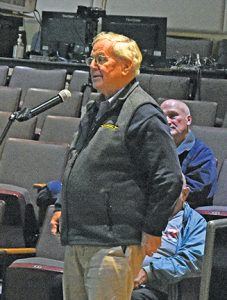
Bob Mitchell, who owns RA Mitchell on Route 6 near the Fairhaven-New Bedford swing bridge, addresses the MassDOT panel at a public meeting on 10/3/22 at Fairhaven High School to discuss options for replacing the bridge. Photo by Beth David.
Bob Mitchell, who owns RA Mitchell on Popes Island suggested that they do something with the lights at the so-called “octopus” intersection. He said the Fairhaven side (east) clears out faster than the New Bedford (west) direction. People are not only stuck at the long bridge opening but then they are stuck at several light cycles at the intersection.
“It is a pain,” said Mr. Mitchell.
Ms. Haznar said light signals will be studied. The octopus is a city system, not state, she said, but they would work with the city.
Select Board member Bob Espindola noted that they had a unique opportunity to use federal money for the project, too.
“If not now, when?” he asked.
Rep. Bill Straus said the money could come from a variety of sources, including reimbursement from the federal government.
Mr. Cole noted that the traffic studies will include the “whole corridor,” from Route 195 to New Bedford. He said traffic counts are underway, and with school in session it is a “big difference.” They hope to be at the 25% design phase next fall.
After the meeting Ms. Powers told the Neighb News she did not realize there were skeptics about having a bridge at all.
“That was interesting,” she said. “Traffic would be unbearable for the rest of the community.”
She said business owners and other stakeholders need to be “engaged a little more closely. So I’ll be pushing for that.”
Project inquiries, written statements and other exhibits regarding the proposed undertaking may be submitted to Carrie E. Lavallee, P.E., Chief Engineer, via e-mail to dot.feedback.highway@state.ma.us or via US Mail to Suite 7210, 10 Park Plaza, Boston, MA 02116, Attention: Major Projects, Project File No. 612557.
Statements and exhibits intended for inclusion in the public meeting transcript must be emailed or postmarked no later than ten (10) business days after the meeting is posted to the MassDOT website at https://tinyurl.com/39p3e37n
The website is still being developed. Check on the MassDOT website for updates and search for 612557.
•••
Click here to download the entire 10/6/22 issue: 10-06-22 BridgeMtg
Support local journalism, donate to the Neighb News with PayPal



